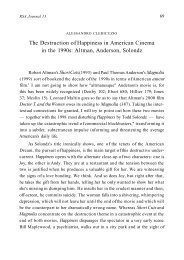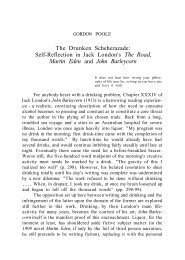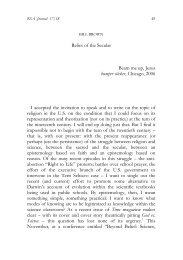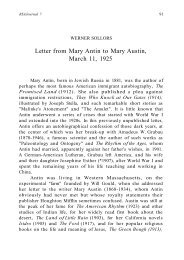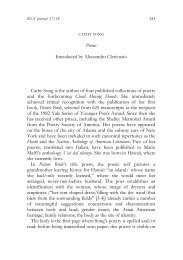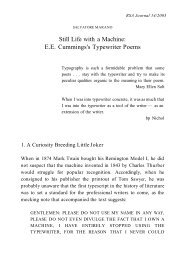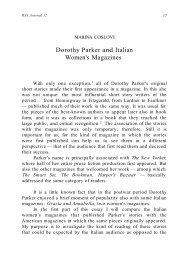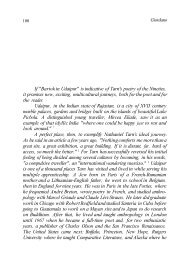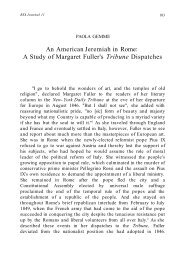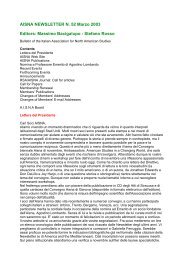Myth and Carnival in Robert Coover's The Public Burning - aisna
Myth and Carnival in Robert Coover's The Public Burning - aisna
Myth and Carnival in Robert Coover's The Public Burning - aisna
- No tags were found...
Create successful ePaper yourself
Turn your PDF publications into a flip-book with our unique Google optimized e-Paper software.
6 Da<strong>in</strong>otto<strong>in</strong> most of <strong>Coover's</strong> fiction there exists a tension between the process ofman creat<strong>in</strong>g his fictions <strong>and</strong> his desire to assert that his systems have an<strong>in</strong>dependent existence of their own. For Coover, this tension typicallyresults <strong>in</strong> man los<strong>in</strong>g sight of the fictional basis of his systems <strong>and</strong>eventually becom<strong>in</strong>g trapped with<strong>in</strong> them. (McCaffery 25-26)Similarly, Marc Chénetier argues that, for Coover, fictionsorganize mean<strong>in</strong>g, but they also gel it, they arrange between the world<strong>and</strong> the self a sumptuously embroidered screen of sortileges that is hardto remove at will (fasc<strong>in</strong>um), a screen that cl<strong>in</strong>gs too tightly to what it issupposed to reveal <strong>and</strong> takes its place... <strong>Myth</strong>ification... is, <strong>in</strong> propriotempore, mystification, a cha<strong>in</strong> of choices <strong>and</strong> <strong>in</strong>ventions, someth<strong>in</strong>g likea structure forever after prearranged, a narrative pall from under whichit becomes highly strenuous to escape. (Chénetier 1988, 87)In both McCaffery's <strong>and</strong> Chénetier's statements, one notices anecho of Kermode's dist<strong>in</strong>ction between fiction as pragmatic explanationof the world <strong>and</strong> the hypostasis of fiction onto the plane of myth as"agent of stability [<strong>and</strong>] call for absolute" (Kermode 39). When "aseries of overlapp<strong>in</strong>g fictions [that] cohere <strong>in</strong>to a conv<strong>in</strong>c<strong>in</strong>g semblanceof historical cont<strong>in</strong>uity <strong>and</strong> logical truth" (PB 122) is "mythified" <strong>and</strong>its artificial nature is forgotten, the historical necessities <strong>and</strong> logicaltruths thus created may seize control over human life <strong>in</strong> the name ofReason, Patriotism, <strong>and</strong> Righteousness. Put <strong>in</strong> a different perspective,a heuristic of reality can be stabilized <strong>in</strong>to absolute truth, <strong>and</strong> thuscreate the entropic episteme (<strong>in</strong> Foucault's terms) of a social <strong>and</strong>political order. Once a whole society is entrapped <strong>in</strong> a "mythification"of reality, a totalitarian control can start its work of repression, aim<strong>in</strong>gat coerc<strong>in</strong>g everyth<strong>in</strong>g <strong>and</strong> everybody <strong>in</strong>to the framework of myth.If myth, narratively speak<strong>in</strong>g, is a story that organizes the real asa mean<strong>in</strong>gful experience, it is also, ideologically, a way to organize asocial reality as a mean<strong>in</strong>gful unicum <strong>and</strong> to reduce conflicts <strong>and</strong>differences to a totality of sorts. <strong>The</strong> ritualistic fire of the apocalypse orthe holocaust is, for Coover, the symbolic agency of this ideologicalreduction. This ritualistic power of symbolic fire, agent for thepurification <strong>and</strong> reconstitution of the social body, has been s<strong>in</strong>gled outby Gaston Bachelard:



